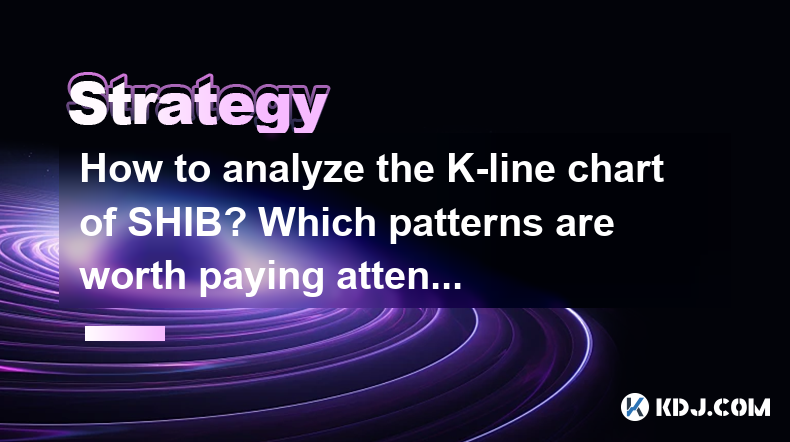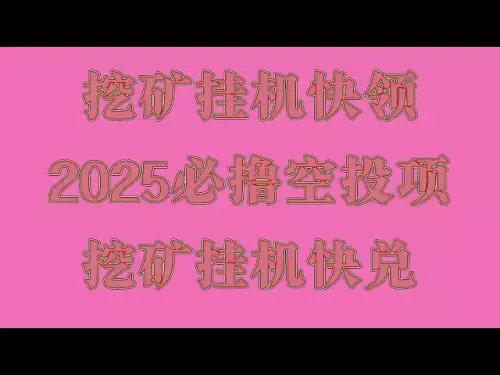-
 bitcoin
bitcoin $110047.851143 USD
-1.37% -
 ethereum
ethereum $3727.617466 USD
-1.30% -
 tether
tether $1.000961 USD
-0.05% -
 bnb
bnb $1114.045467 USD
1.72% -
 xrp
xrp $2.343280 USD
0.14% -
 solana
solana $174.674876 USD
-5.85% -
 usd-coin
usd-coin $0.999999 USD
0.02% -
 tron
tron $0.311757 USD
-2.44% -
 dogecoin
dogecoin $0.183678 USD
-3.76% -
 cardano
cardano $0.627109 USD
-2.07% -
 ethena-usde
ethena-usde $1.000300 USD
0.15% -
 hyperliquid
hyperliquid $36.865760 USD
-2.74% -
 chainlink
chainlink $16.968918 USD
-1.48% -
 stellar
stellar $0.318159 USD
0.47% -
 bitcoin-cash
bitcoin-cash $500.637224 USD
-1.56%
How to analyze the K-line chart of SHIB? Which patterns are worth paying attention to?
Analyzing SHIB's K-line chart involves identifying patterns like Doji, Hammer, and Engulfing, and using indicators like RSI and Bollinger Bands to confirm trends and potential reversals.
May 02, 2025 at 01:21 pm

Understanding how to analyze the K-line chart of SHIB (Shiba Inu) is crucial for any cryptocurrency trader or investor looking to make informed decisions. The K-line chart, also known as the candlestick chart, provides a visual representation of price movements over a specific period. By analyzing these charts, you can identify patterns that may indicate future price movements. In this article, we will explore the essential steps to analyze the K-line chart of SHIB and highlight the patterns that are worth paying attention to.
Understanding the Basics of K-line Charts
Before diving into the analysis, it's important to understand the basics of K-line charts. Each candlestick on the chart represents the price movement of SHIB over a set period, which could be a minute, hour, day, or any other timeframe. The body of the candlestick shows the opening and closing prices, while the wicks or shadows indicate the highest and lowest prices reached during that period.
- Bullish Candlestick: If the closing price is higher than the opening price, the candlestick is typically colored green or white, indicating a bullish trend.
- Bearish Candlestick: If the closing price is lower than the opening price, the candlestick is typically colored red or black, indicating a bearish trend.
Setting Up Your Chart
To begin analyzing the K-line chart of SHIB, you need to set up your chart correctly. Here are the steps to do so:
- Choose a reliable trading platform: Platforms like Binance, Coinbase, or TradingView offer robust charting tools.
- Select the appropriate timeframe: Depending on your trading strategy, choose a timeframe that suits your needs, such as 1-minute, 1-hour, or 1-day charts.
- Add necessary indicators: Common indicators include Moving Averages, Relative Strength Index (RSI), and Bollinger Bands. These can help you identify trends and potential reversal points.
Identifying Key Patterns
Analyzing the K-line chart involves identifying patterns that can signal potential price movements. Here are some key patterns worth paying attention to:
Doji
A Doji is a candlestick pattern where the opening and closing prices are very close to each other, resulting in a small or non-existent body. This pattern indicates indecision in the market and can signal a potential reversal.
- Long-legged Doji: This occurs when the wicks are significantly longer than the body, indicating a high level of volatility.
- Dragonfly Doji: This pattern has a long lower wick and no upper wick, suggesting a potential bullish reversal.
- Gravestone Doji: This pattern has a long upper wick and no lower wick, suggesting a potential bearish reversal.
Hammer and Hanging Man
The Hammer and Hanging Man patterns are similar in appearance but occur in different market contexts.
- Hammer: This pattern appears during a downtrend and has a small body with a long lower wick. It suggests a potential bullish reversal.
- Hanging Man: This pattern appears during an uptrend and has a small body with a long lower wick. It suggests a potential bearish reversal.
Engulfing Patterns
Engulfing patterns occur when a candlestick completely engulfs the body of the previous candlestick. These patterns can signal strong reversals.
- Bullish Engulfing: This pattern occurs at the end of a downtrend when a bullish candlestick engulfs the previous bearish candlestick.
- Bearish Engulfing: This pattern occurs at the end of an uptrend when a bearish candlestick engulfs the previous bullish candlestick.
Morning and Evening Stars
Morning and Evening Star patterns are three-candlestick patterns that can signal reversals.
- Morning Star: This pattern occurs at the end of a downtrend and consists of a long bearish candlestick, followed by a small-bodied candlestick (which can be bullish or bearish), and then a long bullish candlestick. It suggests a potential bullish reversal.
- Evening Star: This pattern occurs at the end of an uptrend and consists of a long bullish candlestick, followed by a small-bodied candlestick (which can be bullish or bearish), and then a long bearish candlestick. It suggests a potential bearish reversal.
Analyzing Trends and Support/Resistance Levels
In addition to identifying patterns, it's important to analyze trends and support/resistance levels on the K-line chart of SHIB.
- Trend Analysis: Use moving averages to identify the overall trend. A rising moving average indicates an uptrend, while a falling moving average indicates a downtrend.
- Support and Resistance Levels: These are price levels where the SHIB price has historically struggled to move beyond. Support levels are where the price tends to find a floor, while resistance levels are where the price tends to find a ceiling.
Using Indicators to Confirm Patterns
While patterns can provide valuable insights, it's essential to use indicators to confirm these patterns. Here are some common indicators and how to use them:
- Moving Averages: Use the 50-day and 200-day moving averages to identify long-term trends. A crossover of these averages can signal a trend change.
- Relative Strength Index (RSI): The RSI measures the speed and change of price movements. An RSI above 70 indicates overbought conditions, while an RSI below 30 indicates oversold conditions.
- Bollinger Bands: These bands consist of a moving average and two standard deviations plotted above and below it. When the price touches the upper band, it may be overbought, and when it touches the lower band, it may be oversold.
Practical Example: Analyzing SHIB's K-line Chart
Let's walk through a practical example of analyzing SHIB's K-line chart using the steps and patterns discussed above.
- Step 1: Set up the chart: Open your trading platform and select SHIB. Choose a 1-day timeframe and add the 50-day and 200-day moving averages, RSI, and Bollinger Bands.
- Step 2: Identify the trend: Look at the moving averages. If the 50-day moving average is above the 200-day moving average, SHIB is in an uptrend. If it's below, SHIB is in a downtrend.
- Step 3: Look for patterns: Scan the chart for patterns like Doji, Hammer, Hanging Man, Engulfing, and Morning/Evening Stars. For example, if you spot a Bullish Engulfing pattern at a support level, it could signal a potential bullish reversal.
- Step 4: Confirm with indicators: Check the RSI to see if it's in oversold territory (below 30), which could confirm the bullish reversal signal. Also, look at the Bollinger Bands to see if the price is touching the lower band, indicating potential oversold conditions.
- Step 5: Identify support and resistance levels: Mark the key support and resistance levels on your chart. If the price is approaching a support level and you see a bullish pattern, it could be a good entry point.
Frequently Asked Questions
Q: How often should I check the K-line chart of SHIB?A: The frequency of checking the K-line chart depends on your trading strategy. For day traders, checking the chart every few minutes or hours may be necessary. For long-term investors, checking the chart daily or weekly might be sufficient.
Q: Can I use the same patterns and indicators for other cryptocurrencies?A: Yes, the patterns and indicators discussed in this article can be applied to other cryptocurrencies. However, each cryptocurrency may have unique characteristics, so it's important to adapt your analysis accordingly.
Q: What should I do if I see a bearish pattern on the SHIB chart?A: If you see a bearish pattern, it could be a signal to sell or short SHIB, depending on your risk tolerance and trading strategy. Always confirm the pattern with indicators and consider the overall market context before making a decision.
Q: Are there any tools that can help automate the analysis of SHIB's K-line chart?A: Yes, there are several tools and platforms that offer automated analysis features, such as TradingView and Cryptohopper. These tools can help identify patterns and trends, but it's important to understand the underlying analysis to make informed decisions.
Disclaimer:info@kdj.com
The information provided is not trading advice. kdj.com does not assume any responsibility for any investments made based on the information provided in this article. Cryptocurrencies are highly volatile and it is highly recommended that you invest with caution after thorough research!
If you believe that the content used on this website infringes your copyright, please contact us immediately (info@kdj.com) and we will delete it promptly.
- XRP Price Prediction: Weekend Rollercoaster or Rally?
- 2025-10-12 08:45:16
- Bittensor (TAO): Super Bullish Signals Point to Potential 2x Rally
- 2025-10-11 10:25:12
- Silver Price Correction: Navigating the Dip & Identifying Key SEO Keywords
- 2025-10-11 10:25:12
- Decoding Crypto Trends: Bittensor's Bull Run, Cardano's Dip, and LivLive's Presale Buzz in 'Uptober 2025'
- 2025-10-12 08:45:16
- MoonBull: The Crypto Meme Coin Promising 1000x Gains?
- 2025-10-11 10:30:01
- Crypto Payroll Revolution: Stablecoins, Altcoins, and the Future of Salary Payments
- 2025-10-11 10:30:01
Related knowledge

Practical parameter settings for a Bitcoin multi-timeframe moving average system
Sep 18,2025 at 10:54pm
Optimizing Timeframe Combinations for Bitcoin Trading1. Selecting appropriate timeframes is crucial when building a multi-timeframe moving average sys...

How can I filter out false breakouts in Dogecoin high-frequency trading?
Sep 22,2025 at 01:00am
Understanding False Breakouts in Dogecoin Trading1. A false breakout occurs when Dogecoin's price appears to move beyond a defined support or resistan...

Techniques for identifying tops and bottoms in the Bitcoin on-chain NVT model
Sep 20,2025 at 07:54pm
Understanding the NVT Model in Bitcoin Analysis1. The Network Value to Transactions (NVT) ratio is often described as the 'P/E ratio' of the cryptocur...

What does the surge in open interest in Bitcoincoin futures mean?
Sep 20,2025 at 11:18pm
Understanding the Surge in Dogecoin Futures Open Interest1. A surge in open interest within Dogecoin futures indicates a growing number of active cont...

How can I use the Ethereum USDT premium to gauge market sentiment?
Sep 18,2025 at 11:55pm
Understanding the Ethereum USDT Premium1. The Ethereum USDT premium refers to the price difference between USDT (Tether) traded on Ethereum-based plat...

What should I do if Ethereum staking yields decline?
Sep 20,2025 at 06:18am
Understanding the Causes Behind Declining Ethereum Staking Yields1. The Ethereum network transitioned to a proof-of-stake consensus mechanism with the...

Practical parameter settings for a Bitcoin multi-timeframe moving average system
Sep 18,2025 at 10:54pm
Optimizing Timeframe Combinations for Bitcoin Trading1. Selecting appropriate timeframes is crucial when building a multi-timeframe moving average sys...

How can I filter out false breakouts in Dogecoin high-frequency trading?
Sep 22,2025 at 01:00am
Understanding False Breakouts in Dogecoin Trading1. A false breakout occurs when Dogecoin's price appears to move beyond a defined support or resistan...

Techniques for identifying tops and bottoms in the Bitcoin on-chain NVT model
Sep 20,2025 at 07:54pm
Understanding the NVT Model in Bitcoin Analysis1. The Network Value to Transactions (NVT) ratio is often described as the 'P/E ratio' of the cryptocur...

What does the surge in open interest in Bitcoincoin futures mean?
Sep 20,2025 at 11:18pm
Understanding the Surge in Dogecoin Futures Open Interest1. A surge in open interest within Dogecoin futures indicates a growing number of active cont...

How can I use the Ethereum USDT premium to gauge market sentiment?
Sep 18,2025 at 11:55pm
Understanding the Ethereum USDT Premium1. The Ethereum USDT premium refers to the price difference between USDT (Tether) traded on Ethereum-based plat...

What should I do if Ethereum staking yields decline?
Sep 20,2025 at 06:18am
Understanding the Causes Behind Declining Ethereum Staking Yields1. The Ethereum network transitioned to a proof-of-stake consensus mechanism with the...
See all articles










































































